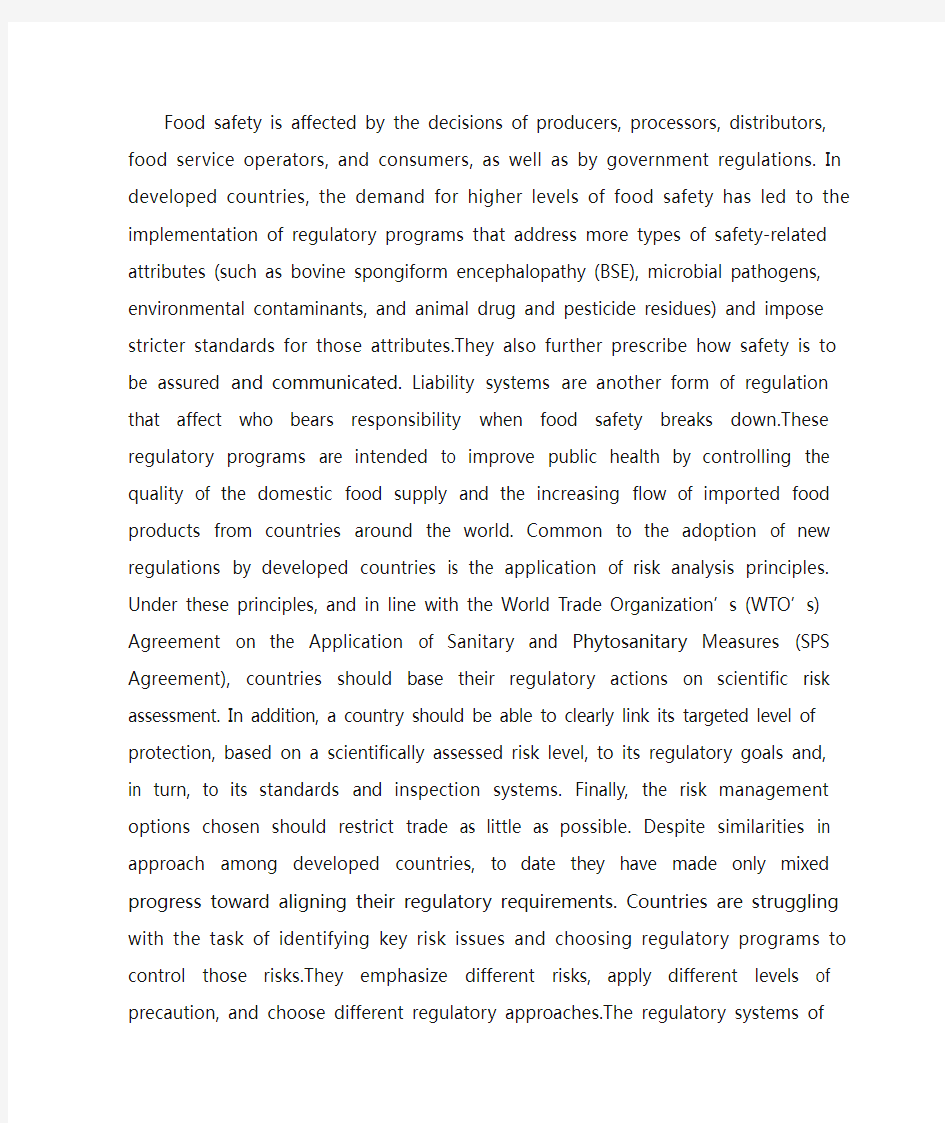
食品安全外文文献
- 格式:docx
- 大小:21.17 KB
- 文档页数:4


Food safety is affected by the decisions of producers, processors, distributors, food service operators, and consumers, as well as by government regulations. In developed countries, the demand for higher levels of food safety has led to the implementation of regulatory programs that address more types of safety-related attributes (such as bovine spongiform encephalopathy (BSE), microbial pathogens, environmental contaminants, and animal drug and pesticide residues) and impose stricter standards for those attributes.They also further prescribe how safety is to be assured and communicated. Liability systems are another form of regulation that affect who bears responsibility when food safety breaks down.These regulatory programs are intended to improve public health by controlling the quality of the domestic food supply and the increasing flow of imported food products from countries around the world. Common to the adoption of new regulations by developed countries is the application of risk analysis principles. Under these principles, and in line with the World Trade Organization’s (WTO’s) Agreement on the Application of Sanitary and Phytosanitary Measures (SPS Agreement), countries should base their regulatory actions on scientific risk assessment. In addition, a country should be able to clearly link its targeted level of protection, based on a scientifically assessed risk level, to its regulatory goals and, in turn, to its standards and inspection systems. Finally, the risk management options chosen should restrict trade as little as possible. Despite similarities in approach among developed countries, to date they have made only mixed progress toward aligning their regulatory requirements. Countries are struggling with the task of identifying key risk issues and choosing regulatory programs to control those risks.They emphasize different risks, apply different levels of precaution, and choose different regulatory approaches.The regulatory systems of countries are a mix of old laws and newer regulations that frequently do not apply consistent standards across products, risks, or countries of origin. Finally, countries may be tempted to use food safety regulations as a means of protecting domestic industries from foreign competition. These features of food safety regulation in developed countries have several implications for developing countries. First, they determine access to growing markets for food exports, particularly high-value fresh commodities such as those discussed in other briefs in this collection.When standards differ, this can create additional barriers for developingcountry exporters. Second, these features determine the issues that will be addressed in international forums, such as the Codex Alimentarius Commission.Third, they create expectations among developing-country consumers regarding acceptable levels of safety and set examples for emerging regulations in developing-country food systems. This brief reviews emerging regulatory approaches and the implications for developing countries. REGULATORY APPROACHES Countries regulate food safety through the use of process, product (performance), or information standards. Process standards specify how the product should be produced. For example, Good Manufacturing Practices specify in-plant design, sanitation, and operation standards. Product (performance) standards require that final products have specific characteristics. An example is the specification of a maximum microbial pathogen load for fresh meats and poultry. Finally, information standards specify the types of labeling or other communication